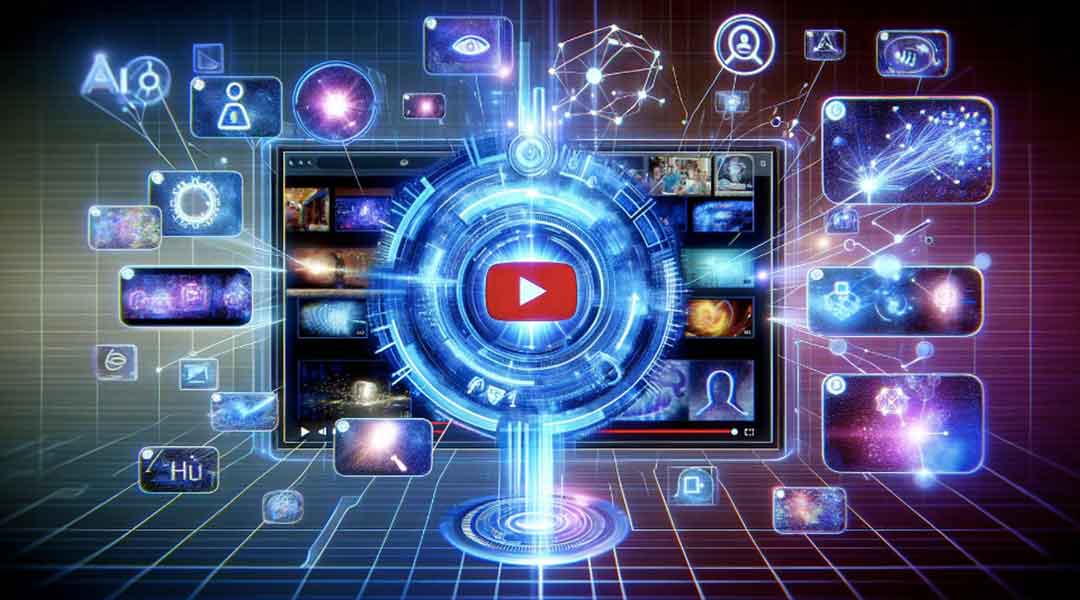YouTube has unveiled a new AI labeling tool to tag videos with “Altered or synthetic content.” This move aims at curbing the rise of AI-generated misinformation. Despite announcing its readiness for Monday’s launch, some users find the feature absent when uploading content.
Companies struggle with digital falsehoods on platforms like YouTube. This latest initiative aims to increase transparency for AI-created videos, a significant step as many go unrecognized on social media.
Understanding YouTube AI Content Labeling
When YouTube detects altered or synthetic footage, a label will appear in the video description. This move aims to tackle AI-generated misinformation spreading online rapidly. Our expertise tells us this is key for maintaining trust and transparency on the platform.
Many videos currently exist without labels despite being fully or partly AI-crafted. Some even use edited thumbnails to evoke certain emotions. Interestingly enough, not all uses of artificial intelligence require disclosure according to YouTube’s criteria. Simple enhancements like script generation won’t need labeling – only content intended to deceive by imitating real voices would be tagged as “Altered” material.
They plan to roll out first on mobile apps, then desktops and TV interfaces soon after, but there isn’t a clear deadline set yet for these changes. Creators who repeatedly don’t disclose may eventually face penalties from YouTube, which suggests that proper usage of their forthcoming tools will become increasingly important, particularly when considering one’s credibility online.
Exploring the New Content Tool
YouTube’s AI Content Label Tool is smart; it knows that our online world is full of altered images or videos. We see a storm hit a town, but did it really? Now, creators must tell us if they used tech to make fake things look real. YouTube’s move demands honesty. Say you hear Drake on a new track; it could be him or an AI twist. If his label doesn’t like it, a takedown follows. The average person isn’t so lucky, though; getting deepfakes off your back means paperwork with YouTube reviewing every bit. The platform bets on users’ truthfulness for now, as their detection tools aren’t perfect yet. They might tag content themselves if there’s a risk of deception.
YouTube leans hard into clarity where we need truths most, health guides or election info will wear these labels clearly for all eyes to catch right away. As we parse through this update in detail, remember: what shines here is transparency, the core element Google E-E-A-T embodies for both viewers and creators alike navigating digital trustworthiness today.
AI Content Labels Explained
YouTube’s fresh approach to AI content labeling is straightforward. If you use an AI tool for scriptwriting or automating captions, no label is needed—YouTube gets that these are just productivity boosts. The same goes if your video is clearly in fantasy land. Think animations or a person atop a unicorn where reality isn’t the point.
However, transparency takes center stage when alterations affect authenticity, such as using tech to mimic real people saying things they never did. That’s where labels step in, under each clip’s description with details on whether it was flagged as altered synthetic media. For us creators who value genuine content creation and viewer trust above all else, this initiative balances innovation without compromising integrity and ensures our audience always knows what they’re watching.
YouTube’s Latest AI Update
YouTube’s new policy shapes our digital world. Creators must now reveal if videos are altered by AI, ensuring transparency for viewers. Labels will soon appear on such content. This is vital since some might deceive audiences without their knowledge.
When uploading, creators indicate whether they’ve used AI to craft realistic yet synthetic material, like events or actions never truly happening. Heavier labels come with sensitive topics, and non-compliant media faces removal despite labeling efforts. The platform takes a firm stance: it’ll nix content like fake violence meant to shock or repulse us all.
Moreover, YouTube’s own generative tools producing altered output will be clearly marked as well. We also see a change ahead in privacy protections where individuals can request takedowns of fraudulent representations involving one’s face or voice.
Navigating YouTube’s AI Features
YouTube’s AI features for content labeling can seem dense, but they’re here to help us – the creators and marketers. When you upload a video, YouTube’s algorithms work fast. They scan your title, description, and tags, and then they watch your video like any user would.
The AI picks out what matters: words spoken or shown on screen are key. Now imagine this tool flags up certain themes in your videos; that’s where it becomes really useful! It hints at which audience will likely find them interesting.
Say it notices tech jargon throughout; that could mean targeting gadget lovers is smart. That comes from the proper descriptions we provide when uploading our stuff. Don’t skimp there! Also crucial is to check the automated captions YouTube generates. They need to be spot-on, too!
Make changes if necessary because these influence how the algorithm understands and labels your content. So keep tabs after posting as well. The feedback loop with views and comments also guides future uploads through insights into what resonates best with viewers.
Implications for Video Creators
For us video creators, YouTube’s new AI Content Labeling tool is a game-changer. We now have to mark our videos if they use AI that looks real. If we don’t tell the truth about our content being altered or made by an AI and it could fool people into thinking it’s not synthetic, there are big risks involved.
If I keep forgetting to label properly, my channel might get hit hard; think of having videos taken down or even losing out on money-making opportunities with YouTube’s Partner Program. This update isn’t just for show. It has serious implications ahead of elections when accurate information is critical. Remember: this rule only applies if the artificial stuff in your video can be mistaken for reality, like deepfakes, or covers hot issues like politics right where they stand out most on your screen.
Simple things like script help from an AI won’t need labeling; neither will obvious computer-made graphics. So individuals who craft their stories using these smart tools must stay sharp, we’ve got more responsibility than ever before to ensure viewers know what’s real and what’s a brilliantly crafted illusion.
Content Label Impact on Viewership
YouTube’s content label initiative directly affects viewer trust. They’ll soon spot a new type of tag on certain videos, a clear marker whenever altered or synthetic media makes up part, or all, of what they’re watching. This isn’t just for any video; it’s particularly crucial when we talk about sensitive areas like healthcare advice, news updates, financial guidance, and election-related information.
The labels’ design is to be straightforward yet noticeable, integrated within the extended description space underneath each video. For higher-stakes topics though? Expect these advisories right on the footage itself; hard to miss indeed as you watch.
Creators get breathing room here. They have time handed to them by YouTube before strict rules kick in regarding label usage consistency across their uploads. But heed this: if there seems a risk that AI-manipulated material might bewilder viewers with its realism without due disclosure from the creators themselves, then YouTube steps in with an added badge nonetheless. Viewers craving authenticity will appreciate such efforts toward clarity. Their desire for genuine content is heard loud and clear by platform giants taking responsibility into their own hands.
Managing Videos with AI Labels
It’s clear we face a new challenge when managing videos with AI labels. Creators must indicate if their content has been altered in any way that could deceive viewers. This includes making someone say what they didn’t or changing scenes from reality to fiction.
Especially critical is the use of deepfakes. Digitally swapping faces or voices can manipulate public perception. For sensitive material, YouTube places a visible label on affected videos as an alert for users. While generative AI allows creators to craft wild and imaginative scenarios without disclosure requirements, honesty remains key when realistic elements are involved.
If rules aren’t followed, YouTube may step in with penalties for repeat offenders ranging from adding compulsory labels to taking down deceptive clips altogether, which are vital actions, especially considering upcoming elections where such footage holds potential sway over voters’ opinions. YouTube’s evolving policies aim to protect viewer trust while balancing creative freedom, a delicate act that is indeed essential as technology advances rapidly within our digital ecosystems.
Strategies for Labeled Content
In our work with YouTube’s AI, we’ve found that labeling content correctly is crucial. In my two decades of digital marketing, we have seen many tools come and go. This one stands out for its complexity. Invisible watermarking shows promise for security against tampering because it embeds during creation, yet without reliable detection systems, even these can fail.
We need to blend technologies like watermarking with clear rules and education on synthetic content to truly protect against misinformation. No single method solves the problem entirely. Our strategies must be holistic. YouTube’s tool evaluates techniques such as cryptographic marks, which are good but not perfect by themselves. They’re part of a bigger picture involving user awareness, too.
Only through informed users coupled with robust technology can we address the slippery issue of fake or AI-generated videos effectively. We advocate testing any new regulations in Regulatory Sandboxes before they hit real-world use to refine them alongside feedback from tech experts and everyday people alike.
YouTube’s latest AI tool marks a big leap in content management. It uses complex algorithms to label videos accurately, helping users find what they want faster. This system not only streamlines the search process but also helps advertisers identify suitable content for their brands.
For creators, understanding this new labeling can mean better visibility and more targeted audiences. Staying up-to-date with these changes is key for anyone involved with YouTube, whether creating, consuming, or investing in video content.









